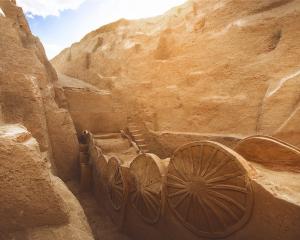Former fisheries scientist Dr John Booth, a specialist in rock lobsters, takes a look at the delicacy many of us covet.
They do not have a voice - but they do make sounds.
Listen carefully to your red rock lobster (you may call it your crayfish). That disturbing sound is the crayfish grinding its mouthparts.
A crustacean version of 'bruxism' (teeth grinding) might be the technical description, although the lobster might not care a jot. It is likely to be more concerned about its immediate fate.
The neighbouring campers you have been getting to know, and like, have dropped in a couple from their early-morning dive.
Grind, grind.
I have read somewhere about thoroughly chilling them before spiking them. On top of the bag of ice for a couple of hours will have to do.
It is staggering just what travellers these lobsters are. Their most extensive trips are when they are very young. They hatch from under their mother's tail in spring and, as "phyllosoma" larvae, spend at least 18 months at sea - really at sea, for they are to be found tens to hundreds of kilometres from land, caught up in eddies and countercurrents.
This very curious-looking life form resembles more a transparent, squashed spider than any lobster.
The vast majority of phyllosomas perish at sea, either eaten or starving.
The lucky ones that are close enough to shore, and have sufficient energy reserves, metamorphose to the post-larval "puerulus" stage.
Here is something which really does look like a rock lobster, but transparent and still very much part of the plankton, getting up off the sea floor as night sets in to swim ever closer to shore.
This is where the puerulus settles, in waters down to about 15m. Within a week or so, it moults into a fully recognisable miniature lobster, about 25mm long.
Your two lobsters are both males (their genital apertures are at the base of their last pair of legs, whereas in females they are at the base of the third pair) and a little over legal size - so they're about 6 years old.
This is about the age that red rock lobsters around much of the country mature (the exception being the east coast of central New Zealand, where the lobsters mature at three or four).
In certain parts of New Zealand, particularly in southern areas, some red rock lobsters migrate great distances, against the prevailing west-to-east current, as they approach maturity.
Happily, their westward trek against the current perpetuates the species, but what is in it for the individuals, and exactly how they navigate, remains a mystery.
It is possible that they have a magnetic sense, as well as using water movements to navigate by, and detecting subtle changes in water chemistry using thousands of chemical-sensory hairs.
So, your lobsters may not only have drifted as larvae hundreds, even thousands, of kilometres, but may also have migrated long distances on the sea floors.
The greatest minimum distance recorded for a migrating adult red rock lobster in New Zealand is 460km.
Red rock lobsters here reach more than half a metre in length, and a weight of 8kg. At that size, they are probably 20 or 30 years old, but we cannot be more specific because all hard parts are lost at the moult, not leaving any part that can be sectioned for its annual rings, as you would a tree trunk.
Growth rates fall once the lobsters mature and more of their energy goes into reproductive output.
Your two lobsters are now completely limp. They do not react at all to being handled; no more sounds of grinding.
Now is the time to spike them. Slide a sharp-pointed knife into the carapace, between the two eyes, to sever the brain.
Try serving the tail meat raw, perhaps with soy and wasabi as a dip.
Lobster facts
Common names: Crayfish, rock lobster, red rock lobster, spiny rock lobster
Scientific name: Jasus edwardsii
Type: Crustacean
Family: Palinuridae - spiny lobsters
Distribution: Mainland New Zealand, Stewart Island, Chatham Islands; and southern Australia from Western Australia to New South Wales.
Habitat: Mainly reef and broken reef areas on open shores, down to 300m.
Size: Up to 8kg and over 0.5m long. About 0.5kg and 0.25m at maturity.
Lifespan: Unknown, but probably about 30 years.
Diet: Omnivorous, but will choose high-value/energy foods such as shellfish.
Reproduction: One clutch of eggs each year, laid in autumn and hatched in spring.
Things you need to know: The lobster is of legal size if the distance between the spine tips on the second segment of the tail is at least 54mm (males) and 60mm (females, in most parts of the country).
Something strange: Some rock lobsters migrate great distances - the longest migration on record for a New Zealand red rock lobster is 460km, and this is a minimum distance. But the larvae travel much further. Lobsters appear capable of true navigation, possibly using magnetic, chemical, and physical cues. Lobsters can sniff out food over a long distance, using thousands of chemical-sensory hairs covering their bodies, particularly their antennae and antennules.












